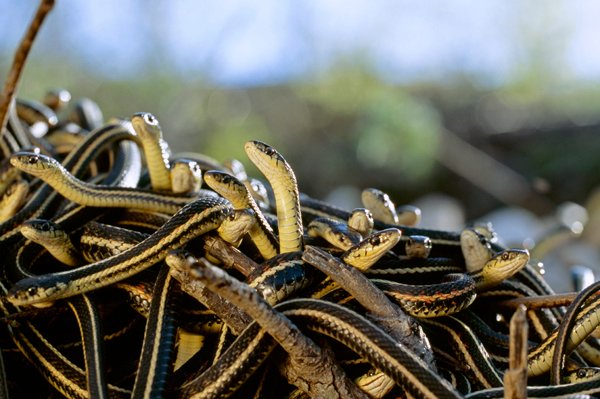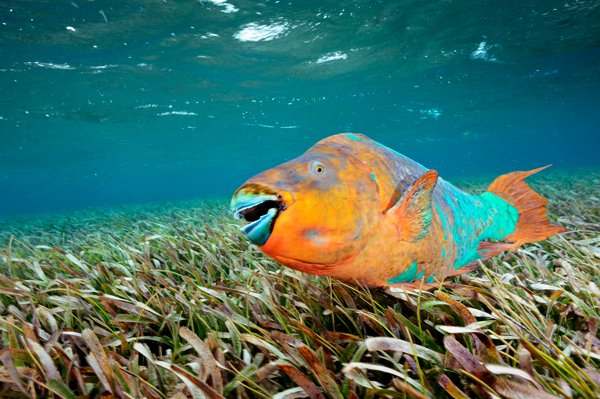we’re not the only animal that’s good at gender alteration. We recently told you about female market squid who flash fake testes, probably to put the kibosh on unwanted male attention. Here are seven creatures who are great at pulling a sexual switcheroo.
Cuttlefish
Admit it: you alter your demeanor, a lot or a little, depending on who you’re with. Just about all of us do it. You’re just not as literal about it as a cuttlefish.
Male mourning cuttlefish actually show a different side of themselves depending on the company they’re with, especially if that company is mixed. A study out of Macquarie University in Sydney found that males can split themselves down the middle, appearing to be male on one side and female on the other. A male in between another male and a female will show his true male appearance to the female to flirt with her, while showing female colors to the male. That other male thinks he’s seeing two ladies (and no rival) and won’t realize that a budding romance is happening right in front of him.
Mr. Roper thinks something funny is going on here but has decided not to get involved.
Garter Snakes
Of all the animal romance rituals, the snake mating ball is certainly one of the most visually arresting, if not downright orgiastic-looking. Guaranteed to give the ophidiophobic a few nightmares, it’s also a squirmy stage for some clever sexual charades.

In Manitoba, Canada, which has the highest concentration of garter snakes in the world, males emerge from hibernation slowly and groggily after eight months in the chilly ground. Pokey they may be, but they’re still on high alert for females to mate with. Some males, though, mimic female behavior at this time.
Researchers think that’s because females have a couple of survival advantages. When females emerge, they are quickly mobbed by male suitors, as are the female-mimicking “she-males.” The snakes at the center of mating balls are protected from predators (birds seek out the groggy males). Plus, all that transferred body heat allows the she-males to warm up more quickly and become fleeter of foot — well, maybe not foot– to avoid becoming lunch.
Snake in the grass? Perhaps. But one that lives to slither another day.
Spotted Hyena
It’s not just the males of the animal kingdom that adopt opposite sex traits. Female spotted hyenas are socially dominant, larger, and more aggressive than the males.

But it’s not only their behavior that’s masculine. Their clitoris is so enlarged it’s often referred to as a pseudo penis. It’s capable of erection, and the female has sex, urinates, and gives birth through it. Females also have a structure that looks remarkably like a scrotum. Even close up, it can be hard to distinguish a female from a male.
There are theories but no definitive reason for the female hyena’s pseudo penis.
“OMG, cool!” probably doesn’t count.
African Bat Bug
The African bat bug sucks the blood of bats (and sometimes bites humans). Cool enough, but even more intriguing, bat bugs have a serious game of strategy going on around their safety and sexual identity. Like bedbugs, bat bugs practice “traumatic insemination,” in which males stab females in the abdomen with needle-like penises and inject sperm directly into the bloodstream, which can harm the female. Males sometimes do this to each other as well.
To protect themselves, females developed paragenitals, a funnel-like genital opening that guides the penis to an area filled with immune cells. Males, then, developed their own version of these paragenitals. Then the females started imitating the more successful male imitations of the female paragenitals. (See pictures: “‘Torture’ Phalluses Give Beetles Breeding Boost.”)
Females imitating males imitating females sounds like it could get seriously confusing. It calls to mind Dr. Seuss’ Sneetches, who changed their appearance so often they couldn’t tell “which one was what one or what one was who.”
But it can’t be too perplexing: The bat bugs continue to reproduce.
Anemonefish, Parrotfish, and Hawkfish
Some animals don’t just appear to change genders—they actually turn into the opposite sex. Clown anemonefish all start out as male. If the female dies, the dominant male can change sex and become female. Another male will become the dominant male.

Parrotfish start out as male or female but have sex organs of both sexes; they are protogynous hermaphrodites, meaning they can change from female to male. Some females will become supermales: larger males with brilliant, lively coloring.
Hawkfish in the wild have been shown to be capable of “bi-directional” sex change, going from female to male and back again.
Kind of poetic that the ocean is home to such elegant gender fluidity.
Source: nationalgeographic.com
Hi! I am a robot. This post is to help manual curators; I have NOT flagged you.
I have detected a potential source:
Please try to refrain from copying articles to Steemit. Even if one links the source, this is still considered plagiarism and can end up in a DMCA notice being sent. You may also be downvoted, and added to a downvote bot's list if your account does this repeatedly.
If I am correct, please edit your post to only link to the article, then provide your own original thoughts on it.
NOTE: I am too dumb to tell if you are the author, so ensure you have proper verification in your post for human curators to check! http://voices.nationalgeographic.com/2013/09/22/7-gender-bending-animals/
Awesome pics!
nice journey, i envy with you because you can go to a really beautifull place ...lol
:)
I finally stumbled on real, complete and interesting article! good job :)